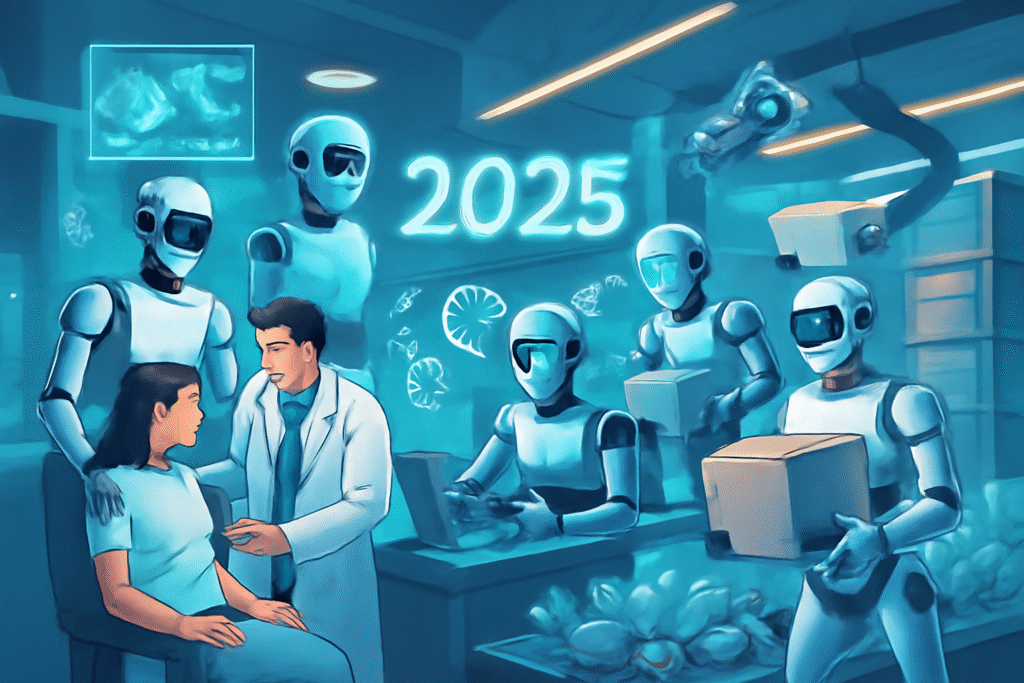
Robots powered by artificial intelligence (AI) are no longer the stuff of futuristic movies—they are rapidly transforming every corner of the global economy in 2025. This year marks a significant surge in the adoption, capabilities, and impact of smart robotics across industries and in our daily lives. From self-learning warehouse bots to empathetic robots in healthcare and customer service, let’s explore how AI-driven robots are shaping our world, the trends fueling this revolution, and what it means for businesses and individuals—especially in fast-growing regions like the Middle East, Southeast Asia, and other emerging GEO markets.
The Global Context: Why Robots and AI Are Booming in 2025
2025 is witnessing an unparalleled synergy between robotics and artificial intelligence. Several primary trends are converging to accelerate adoption and innovation:
- AI’s leap in reasoning and memory: Modern AI systems can learn from vast data sets, remember detailed tasks, and improve autonomously, making today’s robots significantly smarter than those of previous years.
- Industries demand efficiency and customization: Pandemic aftershocks, labor shortages, and the ongoing need for cost reduction have pushed industries to seek flexible automation solutions.
- Inclusivity across company sizes: Major platforms now enable even small and medium-sized organizations to implement smart robots, democratizing once-exclusive technologies.
- Global focus on sustainability and new use cases: Robots are not only helping in factories and logistics hubs, but also in healthcare, agriculture, environmental cleanup, and even the home. 67
Major Trends Defining AI-Powered Robotics in 2025
1. From Task Execution to “Thinking” Robots
Robots in 2025 are equipped with advanced AI and machine learning algorithms, enabling them to process complex data, make real-time decisions, adapt to changing environments, and even engage in creative problem-solving. This makes them ideal for dynamic sectors like logistics, agriculture, healthcare, and retail—far beyond their original niche in repetitive assembly-line tasks.
- Predictive analytics: Robots now forecast equipment failures and optimize maintenance, reducing costly downtime.
- Real-time adaptation: By utilizing embedded sensors and adaptive learning, robots can fine-tune their actions in real-time.
2. Collaborative Robots: The Rise of Cobots
Cobots (collaborative robots) are designed to work safely and intuitively alongside human workers. Innovations in natural language processing and intuitive interfaces mean that even non-technical staff can interact with or “program” robots using spoken commands. Key benefits:
- Rapid upskilling and deployment: No need for lengthy coding or retraining.
- Enhanced workplace safety: Cobots sense human presence and adapt their motion patterns to avoid accidents.
- Flexibility in applications: From assisting surgeons in the operating room to handling inventory in retail warehouses, cobots bridge the human-machine gap, enabling greater efficiency and satisfaction.
3. Autonomous Mobile Robots (AMRs)
Autonomous mobile robots have become a game-changer in sectors like logistics, warehousing, and last-mile delivery:
- Obstacle avoidance: Advanced spatial mapping lets them navigate dynamic environments with ease.
- Peer-to-peer collaboration: Multiple robots coordinate in real-time, ensuring logistical fluidity and accurate deliveries.
4. Humanoid and Empathetic Robots
2025 is the year humanoid robots step out of controlled labs and into real workplaces. From Tesla’s Optimus to affordable humanoids handling logistics or retail support, these robots bring new levels of adaptability.
- Human-like dexterity: Ideal for healthcare, hospitality, and personalized retail services.
- Emotional intelligence: Robots utilize AI to ‘read’ human emotions and tailor their responses, making them valuable as caregivers or customer service assistants.
| Industry | Example Applications (2025) |
|---|---|
| Manufacturing | Smart assembly lines, predictive maintenance, worker–robot collaboration |
Key Enablers: Why This Revolution Is Happening Now
- Plug-and-Produce Systems: Standardized, easily deployable robots lower integration costs, even for small businesses and emerging economies.
- Cloud and Edge AI: Robots process data locally for fast decision-making, while cloud-based AI enables fleet management over vast areas—crucial in logistics, agriculture, and smart cities.
- Smart Sensors: Faster, cheaper, more accurate sensors allow robots to “see,” “hear,” and “feel” their environments.
The Human Factor: Will Robots Replace Jobs or Empower People?
Rather than merely replacing workers, smart robots are taking over repetitive, dangerous, or precision-demanding tasks. Human workers benefit by focusing on higher-level problem-solving, creativity, and customer relations. In regions with skills shortages or safety concerns in the GEO, robots enable companies to maintain and scale operations efficiently. 145
The Road Ahead: Key Predictions for GEO and Beyond
- Increased adoption in emerging markets: Thanks to affordability, intuitive setup, and remote support, AI-powered robots are entering smaller shops and agricultural fields in India, Southeast Asia, Africa, and the Middle East.
- Focus on safety regulations & ethical design: International guidelines ensure that human-robot collaboration remains safe, responsible, and beneficial for communities.
- Rise of AI tutors and service bots: The education and service industries will see robots acting as multilingual tutors and providing 24/7 support staff.
- Sustainability as a standard: Robots are designed with sustainability in mind, reducing waste and supporting climate goals across global supply chains.
Conclusion
If 2025 has proven anything, it’s that robots led by artificial intelligence are not just a trend—they are the new normal in both industry and daily life. Their ability to learn, adapt, and collaborate is transforming the way we work, move goods, care for people, and address global challenges. For fast-growing regions and innovation-minded companies, investing in AI-powered robotics is no longer optional—it’s essential for survival and competitive growth in tomorrow’s world.
Various Sources
https://news.microsoft.com/source/features/ai/6-ai-trends-youll-see-more-of-in-2025/
https://www.mckinsey.com/capabilities/mckinsey-digital/our-insights/the-top-trends-in-tech



